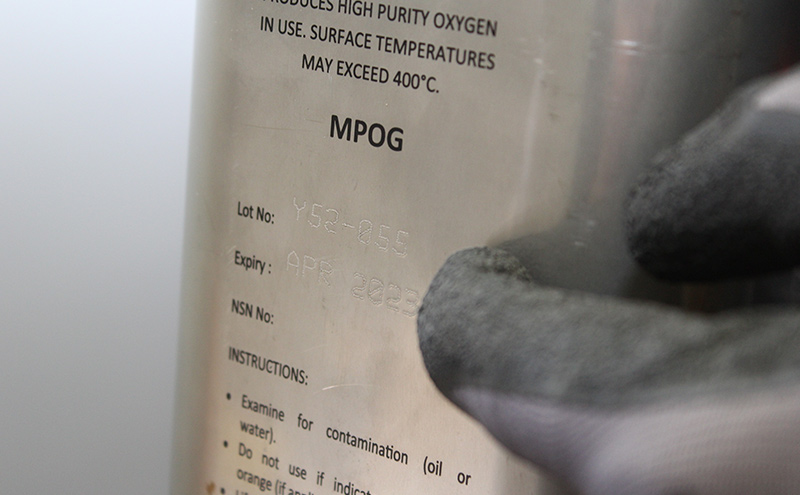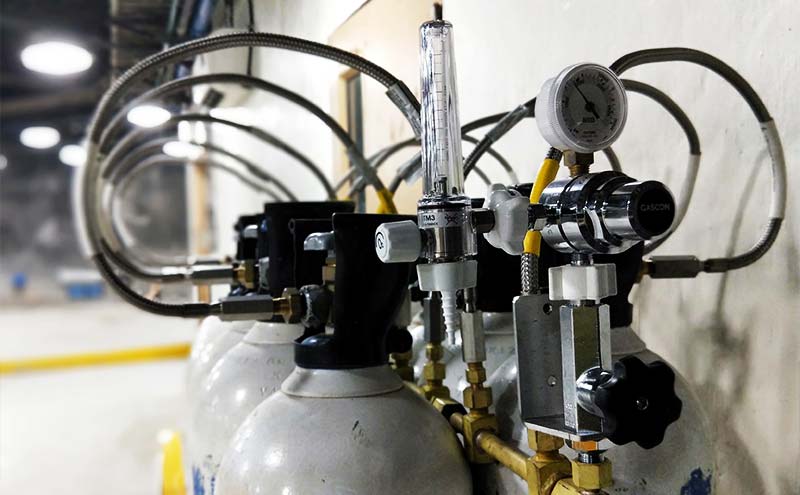Oxygen is essential to sustaining life. Humans are dependent on oxygen for survival; our bodies consume it to produce energy.
Given that a refuge chamber is a sealed environment, it is vitally important to consider the management of oxygen levels inside a refuge chamber. Oxygen levels of the “dead air space” will quickly be consumed and with no breathing supply, occupants would quickly suffocate within a matter of a few hours.
Monitoring and controlling the internal atmosphere, air treatment, and multiple breathable air sources are vital to refuge chamber occupants over entrapment duration.
Emergency Refuge Chamber Oxygen Levels
Amongst other things, ‘breathable air’ or air supplied to a refuge chamber, should contain no less than 19.5% and no greater than 22% by volume of oxygen (AS/NZS 1715:2009).
The typical lower working limit for oxygen levels is 19%. At 18%, a slight increase in breathing effort will occur. At 16% a flame lamp will go out, but still, only a slight increase in breathing and heart rates would be noticeable, and some cognitive impairment may occur. At 14%, impaired judgement and coordination are noticeable. However, as levels fall below 12%, cardiac damage and vomiting can occur. At 10% and below, a lapse into unconsciousness and death will occur.
On the contrary, oxygen levels higher than 23% presents a fire hazard. Though not flammable, oxygen promotes and accelerates combustion, so an oxygen-rich environment increases the combustibility of materials and is undesirable in any environment, particularly a confined space. Hence, handling oxygen supply equipment requires care in ensuring that no grease or oil comes into contact with the oxygen gas flow path.
It is necessary to replace the consumed oxygen, to maintain a level of oxygen that is both safe to breathe and non-hazardous.
How is Oxygen Supplied to a Refuge Chamber?
Replenishing oxygen in a sealed emergency refuge chamber occurs via two standard methods: compressed air and oxygen cylinders.
The most common breathable air sources within a refuge chamber are,
- Incoming, filtered and regulated compressed air from an external source;
- Oxygen cylinders;
- A recommended optional third source is an oxygen candle.
Compressed Air Supply to Emergency Shelters
Compressed air is simply the atmospheric ‘air’ from the surface pushed through pipelines down to the refuge chamber via a compressor.
Before compressed air is suitable for breathing, filtering from airborne water particles, oil contaminants, and pollutants such as carbon monoxide and hydrocarbons from diesel exhausts must occur.
The order of a filtration system’s elements is critical in ensuring the compressed air supplied to a refuge chamber is safe for occupants to breathe.
The MineARC Compressed Air Management System (CAMS) features a four-stage filtration process. CAMS is tested to ISO 12500-1 and designed to meet AS/NZS 1716:2003.
A regulator adjusts the compressed air flow rate into the chamber. The compressed air required to sustain a breathable atmosphere within a safe refuge is calculated at 85L/m (3CFM) for the chamber 85L/m (3CFM) per person after that.
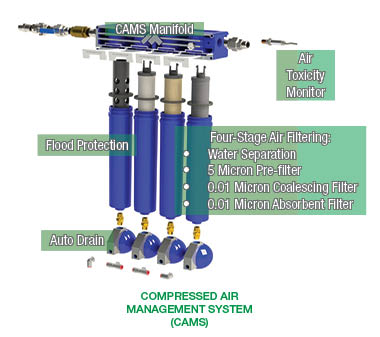
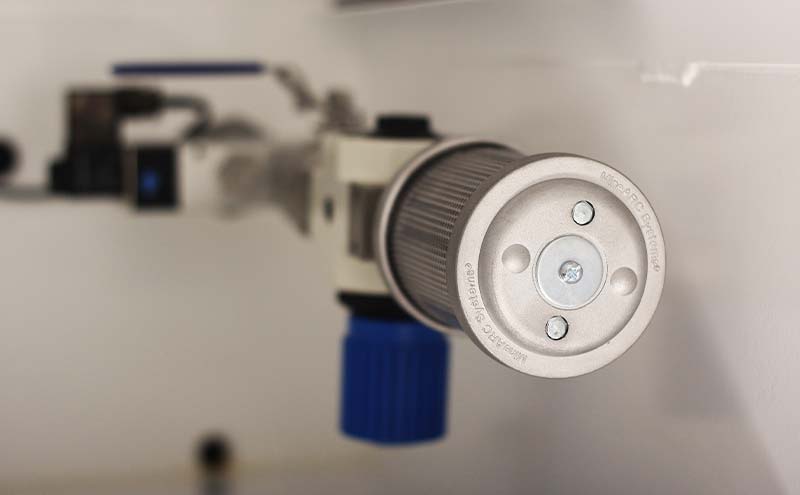
Using Oxygen Cylinders within Sealed Environments
If the compressed air source fails, the refuge chamber must have an independent source of oxygen. MineARC uses medical-grade compressed oxygen from cylinders.
Oxygen cylinders reintroduce O2 into the refuge chamber at the consumption rate. Compressed oxygen is released from a cylinder into the shelter through a regulator that controls the flow rate. Flow is set at the rate of occupant consumption.
Oxygen consumption rates vary from person to person and with activity. For calculations involving the consumption rate of oxygen in refuge chambers, MineARC uses 0.5 Litres per person per minute. This rate allows a safety margin and for variations in individual size and requirements of chamber occupants.
Using this consumption rate, it is possible to work out oxygen supply requirements and how many oxygen cylinders are necessary to meet the total amount of oxygen required for an occupied refuge chamber. This is calculated as follows: number of chamber occupants x rate of consumption x minutes in an hour x number of hours duration.
MineARC recommends using the largest medical grade oxygen cylinder – ‘G size’ – containing 8200L of breathable oxygen. Consideration also needs to be given to whether the regulator used can handle the required flow rate.
In conjunction with oxygen cylinders, air scrubbing is utilised to remove contaminants chemically. Undesired gases like carbon dioxide (CO2) and carbon monoxide (CO) produced in normal human metabolic processes are filtered from the refuge stations internal atmosphere.
Automated Oxygen Delivery Systems for Safe Refuge
An Automated Oxygen Delivery System (AODS) takes the guesswork out of correctly maintaining oxygen levels in the refuge chamber.
Once the system is activated, the AODS continuously measures the internal oxygen level and disperse metered amounts of oxygen from a compressed oxygen cylinder, to maintain oxygen levels between 18.5% and 23% inside the refuge chamber. The system’s flow rate is limited to 15 Litres per minute, suitable for up to 30 persons.
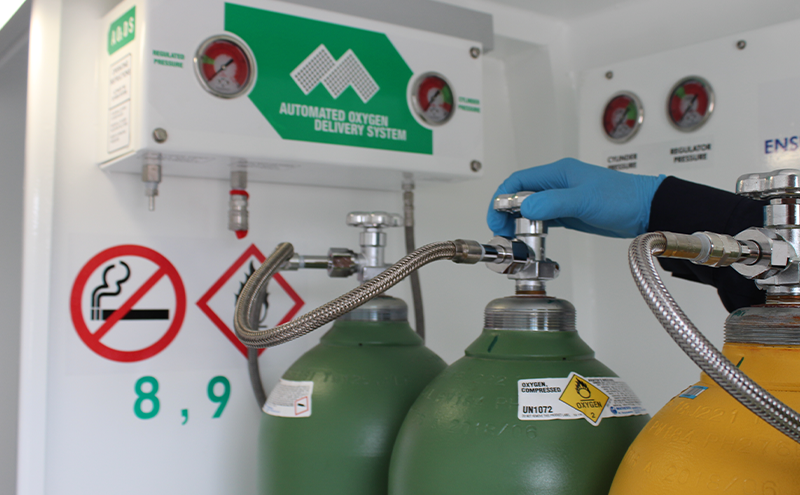
This feature is optional for MineARC Refuge Chambers.
Oxygen Candles for Emergency Refuge Chambers
The oxygen candle is the third and final breathable air supply method. It uses an exothermic chemical reaction to generate oxygen.
An oxygen candle will burn for approximately 60-90 minutes, producing 2600L of oxygen; about 20 hours of breathable air for four people.
Once ignited, it will produce oxygen at a rate of approximately 28 Litres per minute until it is exhausted. An oxygen candle cannot have its oxygen production regulated or halted.
Activation of these candles occurs when both oxygen supplies within the refuge fail, or cylinders are exhausted. Generally in an extreme emergency, to either extend the duration or to buffer a response time to exit the chamber.
